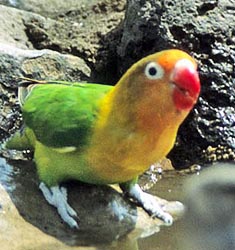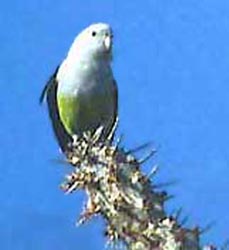| |
LORIES, LOVEBIRDS & OLD WORLD PARROTS Psittaculidae |
- 172 species in the Old World
- DR personal total: 100 species (58%), 31 photo'd
|
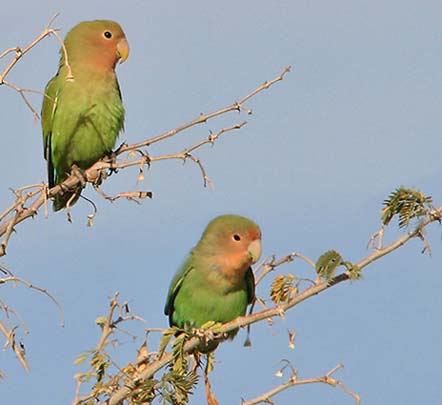 Parrots are a very large group of easily recognized birds, generally restricted to the tropics around the globe. The most recent evidence could be used to group the Psittaciformes into as few as 3 or 4 families, or split them into as many as a dozen families. Following additional evidence on lineages within the parrots [e.g., Schweizer et al. 2011, Joseph et al. 2013, Rheindt et al. 2014], both Cracraft (2013) and the South American Checklist Committee (2014) have adopted a four-family solution. I now take that step for these family pages (more details in the shaded box at bottom of page). Parrots are a very large group of easily recognized birds, generally restricted to the tropics around the globe. The most recent evidence could be used to group the Psittaciformes into as few as 3 or 4 families, or split them into as many as a dozen families. Following additional evidence on lineages within the parrots [e.g., Schweizer et al. 2011, Joseph et al. 2013, Rheindt et al. 2014], both Cracraft (2013) and the South American Checklist Committee (2014) have adopted a four-family solution. I now take that step for these family pages (more details in the shaded box at bottom of page).
The "new" family Psittacidae has all the New World parrots plus two African genera (Psittacus and Poicephalus). Together these comprise 48% of the "traditional" parrots. The remaining 52% are now assigned to the family Psittaculidae, composed of all the Lories, Lovebirds, and all Old World parrots, excepting the two African genera.
This "new" family — it can be called Old World parrots for short — includes many beautiful Australian parrots, such as Mulga Parrot (top photo above), all the Asian species, and the vast majority of African parrots, represented here by a pair of Rosy-faced Lovebirds (left) from southwestern Africa. |
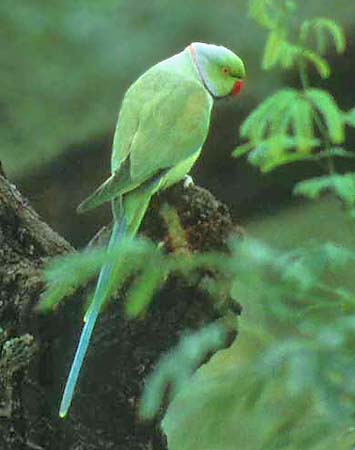 This "new" family of parrots has four major components: This "new" family of parrots has four major components:
- Australian parrots (like Mulga Parrot, shown at the top),
- Lovebirds of Africa (shown above left),
- mostly Asian & north African parrots in tribe Psittaculini — from which the Family name Psittaculidae is derived — that can be represented by the widespread Rose-ringed Parakeet (right), and
- Lories and lorikeets that range through Australasia to south Pacific islands, represented here by Violet-necked Lory of the Moluccas (below).
There are some smaller offshoots aside from these four main elements — such as pygmy-parrots, vasa parrots, and the large Pesquet's Parrot — but the bulk of the psittacids in the new family are within one of these four major groups.
Rose-ringed Parrot (right) has a particularly wide native distribution from sub-Saharan Africa to southeast China. It is also widely kept by aviculturalists, and escapee are rampant is some urban area. It is now a dominant non-native exotic in city parks like Amsterdam, Netherlands. |
|
|
Even though family Psittaculidae has only about half the number of species as the "old" parrot family, there is still amazing diversity among them, including a huge range of sizes. The enigmatic and elusive Pesquet's Parrot of New Guinea (above, a nice photo by Neil Fifer) is 46 cm (1.5 feet) long and weighs up to 800g (almost 2 lbs). It is an ancient parrots in a monotypic tribe. It is a large and ungainly parrot of the New Guinea highlands, moving in small flocks, and is one of the highly sought-after species there by birders. It has been known as " Devil's Parrot" or "Vulturine Parrot," but its name has been changed because there is another parrot with the same name — Vulturine Parrot Pyrilia vulturina of Brazil — in family Psittacidae.
The smallest members of this family are New Guinea pygmy-parrots in genus Micropsitta, but hanging-parrots in genus Loriculus (represented by this Sulawesi Hanging-Parrot, below left) and the Colasisi (or Philippine Hanging-Parrot, below right, in a fine photo by Blake Matheson) are both very tiny. The Colasisi, a Philippine endemic, has a brush-tipped tongue adapted to eating nectar. Very few psittacines (except lorikeets and lories) have this adaptation. |
|
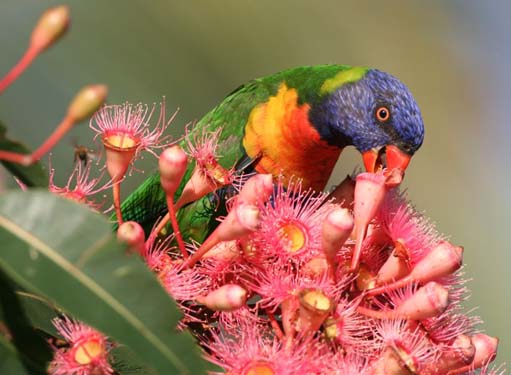 It is the lorikeets and lories, often placed in a subfamily [Loriinae] and sometimes considered their own family (e.g., Clements 1991), that are known for their brush-tipped, nectar-feeding tongues. This Rainbow Lorikeet (left, in a great shot by Murray Lord) is feeding on flowers with that adaptation. There are 53 species in a dozen genera, all confined to Australasia, eastern Indonesia, or remote South Pacific islands. Some are abundant and widespread, like the Rainbow Lorikeet, but many others are scarce and local. It is the lorikeets and lories, often placed in a subfamily [Loriinae] and sometimes considered their own family (e.g., Clements 1991), that are known for their brush-tipped, nectar-feeding tongues. This Rainbow Lorikeet (left, in a great shot by Murray Lord) is feeding on flowers with that adaptation. There are 53 species in a dozen genera, all confined to Australasia, eastern Indonesia, or remote South Pacific islands. Some are abundant and widespread, like the Rainbow Lorikeet, but many others are scarce and local.
Chattering flocks of lorikeets fly fast at tree-top level. Catching a flight of colorful Ornate Lorikeets on Sulawesi (below) was a lucky shot.
Other colorful small parrots in this region, but outside the Loriinae, include six species of pygmy-parrots (Micropsitta) found only in New Guinea and adjacent islands (the Moluccas to the Solomons); six species of fig-parrots in 3 genera, five of them restricted to New Guinea and adjacent islands (one barely reaches n.e. Australia); and the Guaiabero Bolbopsittacus lunulatus of the Philippines. |
|
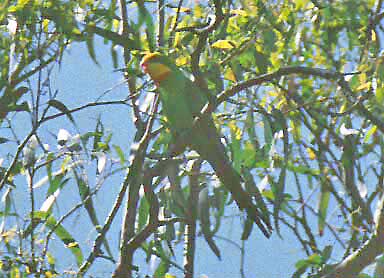
Another tribe [Platycercini, according to Collar 1997] includes many of the famous Australasian parrots, including Budgerigar Melopsittacus undulatus from which the many varieties of pet "Budgies" have been bred. These are 37 species in 14 genera, and many are found in Australia's eucalyptus forest or the dry interior. Among these is the local Superb Parrot (right) and Port Lincoln Parrot (below) of western Australia.
The famed Paradise Parrot Psephotus pucherrimus of interior eastern Australia, once bred in termite mounds. It apparently went extinct about the mid 20th century; there are photos of wild birds, adding to the poignancy. The Night Parrot Geopsittacus occidentalis of the arid interior has also been thought to be near extinction, but there is recent photographic evidence that it still survives. |
|
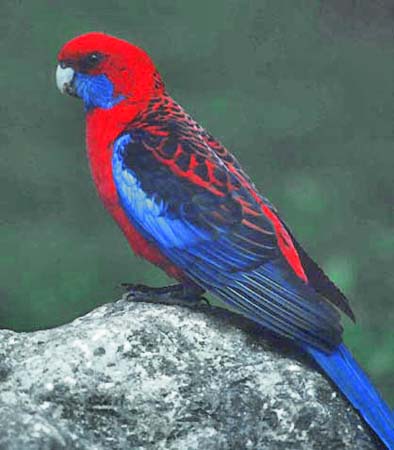 Fortunately, many Australasian parrots are common and widespread, such as Crimson Rosella (left) in eastern Australia. At places like O'Reilly's, in Lamington Nat'l Park, Queensland, or Badger Weir park in Victoria, these wild rosellas have become tame and will eat out of your hand (below). At the latter spot, so will Australian King Parrot (on the girl's left hand), a species that shows strong sexual dimorphism. Another colorful example of an Australian parrot is Red-capped Parrot, endemic to the southwest (just below). Fortunately, many Australasian parrots are common and widespread, such as Crimson Rosella (left) in eastern Australia. At places like O'Reilly's, in Lamington Nat'l Park, Queensland, or Badger Weir park in Victoria, these wild rosellas have become tame and will eat out of your hand (below). At the latter spot, so will Australian King Parrot (on the girl's left hand), a species that shows strong sexual dimorphism. Another colorful example of an Australian parrot is Red-capped Parrot, endemic to the southwest (just below).
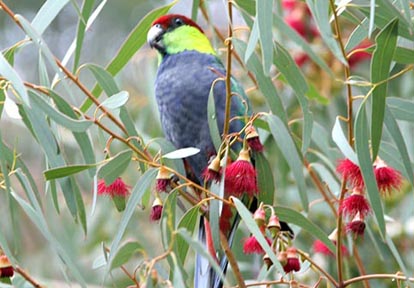
|
|
|
King parrots are listed in the tribe Psittaculini by Collar (1997), among a wide variety of parrots (66 species in a dozen genera in Africa and Asia). This includes the genus Psittacula (14 species), represented here by Alexandrine Parrot (above, drinking from an Indian river). Some are common or widespread. At the other extreme are species on the edge of survival. Parrots in this genus have reached the remote islands in the Indian Ocean; two have gone extinct (in the Seychelles and on Rodrigues) but the Mauritius Parakeet P. echo continues to cling to existence. In November 1992 we saw 8 of 20 birds still left in the wild. There is a small captive breeding program underway that adds some hope for the species' survival.
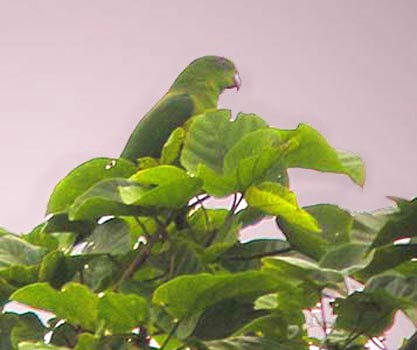 Man has had a long history of association with parrots. Obviously, keeping parrots as pets is a major hobby. Our fascination with parrots is not limited to their beauty and unique bill, but a number of species are good mimics and can be taught to "talk." Many species remain threatened by this commerce. The Red-and-blue Lory Eos histrio of islands north of Sulawesi is currently being "vacuumed" out of existence by a wild parrot trade. The Mindoro Racquet-tail (right), endemic to that single island in the Philippines, qualifies as Vulnerable on the basis that it may have small population – numbering fewer than 10,000 mature individuals – which is inferred to be in on-going decline owing to the continued loss and degradation of optimal habitat and significant trapping pressure (Birdlife International). It is one of ten species of racquet-tail (genus Prioniturus) ranging from the Philippines to the Moluccas, and most species are declining. Collar (1997) has a fine summary of the impact on psittacines by illegal smuggling, plus the hope for the future with strengthened international laws and protocols. Man has had a long history of association with parrots. Obviously, keeping parrots as pets is a major hobby. Our fascination with parrots is not limited to their beauty and unique bill, but a number of species are good mimics and can be taught to "talk." Many species remain threatened by this commerce. The Red-and-blue Lory Eos histrio of islands north of Sulawesi is currently being "vacuumed" out of existence by a wild parrot trade. The Mindoro Racquet-tail (right), endemic to that single island in the Philippines, qualifies as Vulnerable on the basis that it may have small population – numbering fewer than 10,000 mature individuals – which is inferred to be in on-going decline owing to the continued loss and degradation of optimal habitat and significant trapping pressure (Birdlife International). It is one of ten species of racquet-tail (genus Prioniturus) ranging from the Philippines to the Moluccas, and most species are declining. Collar (1997) has a fine summary of the impact on psittacines by illegal smuggling, plus the hope for the future with strengthened international laws and protocols.
|
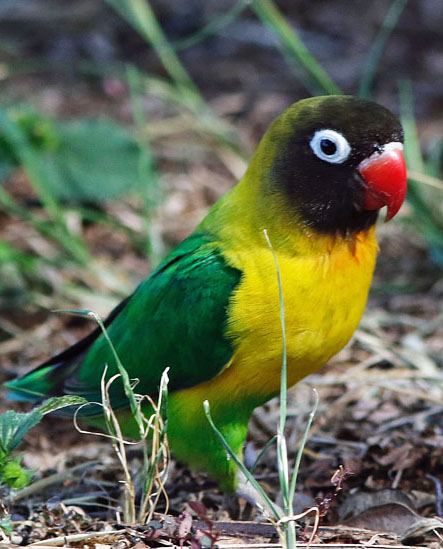
The major African component of this family (setting aside the psittaculid parrots in the north) are 8 species of Agapornis lovebirds in Africa, plus one on Madagascar. Each species is quite lovely; this (left) is Yellow-collared Lovebird, one of two lovebirds that are nearly endemic to Tanzania. The other, drinking at a birdbath pool (inset below left), is Fischer's Lovebird (a few vagrants have reached adjacent counties, and there a some isolated non-native populations in Kenya). Lovebird are small and often colorful species, frequently kept as pets. In the wild they tend to occur in pairs and require water for drinking. Over half of the species have colorful red bills. Black-collared A. swindernianus has a small black bill. Gray-headed Lovebird (inset below right) has a small pale bill. It is the lovebird endemic to Madagascar.
|
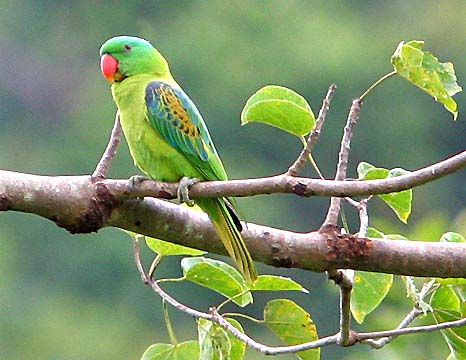
Throughout the world's tropical forests, parrots amuse and amaze. One is often awe-struck by their beauty amidst a backdrop of jungle: check out this Blue-naped Parrot (right) on the island of Mindoro in the Philippines.
Tiger-Parrots (genus Psittacella) creeping through the wet mossy understory in New Guinea are yet another treat, This one (below) is Boehm's Tiger-Parrot from the mountains of New Guinea. Tiger-Parrots are usually quite elusive, but this female is checking out a feeder at Kumul Lodge.
I didn't even get to mention fig-parrots, shining-parrots, or blue-bonnets. I can do little more here than encourage you to seek them out and to enjoy as harbingers of the wild. |
 |
Traditionally, all birds in the Order Psittaciformes were placed in a single Parrot family. Then, Sibley & Ahlquist (1990) and Sibley & Monroe (1990) raised the Cockatoos to family level distinct from the other Parrots. The Handbook of the Birds of the World (Collar 1997) followed the decision. Dickinson (2003) combined them again into a single family [Psittacidae] noting, in footnotes, that various other groups (e.g., Kakapo Strigops habroptila of New Zealand, or the hanging-parrots Loriculus et al.) could also qualify for family status. Christidis & Boles (2008) reviewed the evidence and split the Psittaciformes into three families: the Nestoridae [three New Zealand parrots], the Cacatuidae [Cockatoos], and the rest of them here, in the Psitticidae. I followed that arrangement through my 12th ed. family list.
However, Joseph et al. (2012) divided the Psittaciformes into 6 families: Strigopidae (for the Kakapo,), Nestoridae (for the Kea and Kaka, Nestor, of New Zealand), Cacatuidae (cockatoos), Psittrichasidae (for Psittrichas and Coracopsis = Mascarinus), Psittacidae (for African Psittacus and Poicephalus plus all New World parrots), and Psittaculidae (for all remaining Old World parrots). Cracraft (2013) reduced this to four families: Strigopidae, Cacatuidae, Psittacidae, and Psittaculidae.
Both Schweizer et al. (2011) and Rheindt et al. (2014) offered molecular phylogenies with an analysis of divergence dates. The Rheindt et al. (2014) project not only compared mtDNA and nuclear DNA evidence, but added calibrations based on fossil evidence, thus providing independent evidence to give more confidence to the ages of divergence of lineages. It now appears that the New Zealand parrots diverged about 42–49 mya. The next split from the parrot line was the cockatoos, at about 39–45 mya. Then the main lineage of parrots split into two groups — the African "gray parrots" and all New World parrots in one group, and all remaining Old World parrots in the other group — at about 34–39 mya. The difference in these ranges depends upon whether mtDNA or nuclear DNA is calibrated by the independent fossil evidence. In any event, all available evidence now suggests that these four main psittacid lineages are the four oldest evolutionary lineages.
One could subdivide the Psittaciformes even further, but the age of divergence evidence does not support adding just the two more families suggested by Joseph et al. (2013). The New Zealand endemic Kakapo, proposed as the Strigopidae, diverged from the line of other New Zealand parrots about 27-29 mya; Rheindt et al. (2014). The study by Schweizer et al. (2011) did not include Kakapo but did include Psittrichas [the New Guinea endemic Pesquet's Parrot and Coracopsis, the Madagascar vasa parrots (now Mascarinus)], and together that divergence from other Old World parrots was dated at about 34 mya. This figure may be somewhat high as Schweizer et al. (2011) show the divergence of the New Zealand parrot line to be at about 58–59 mya. When constrained by independent fossil evidence in Rheindt et al. (2014), that divergence shortened to 42–49 mya. Yet, setting aside the variance in dating divergences, the Schweizer et al. (2011) shows at least 3, and maybe 4 other divergences from the Old World parrot line before the divergence of Psittrichas/Coracopsis, including those involving Eclectus Parrot and allies, the lories, and the lovebirds. Using the combined evidence of Schweizer et al. (2011) and Rheindt et al. (2014), if one wished to split all the lineages down to Kakapo as families, one would end up with about 12 families in the Psittaciformes. |
|
| |
Photos: The Mulga Parrot Psephotus various was near Erlunda, N. Territories, Australia, on 18 Aug 2008. The pair of Peach-faced (Rosy-faced) Lovebird Agapornis roseicollis were at Spitzkoppe, Namibia, on 17 July 2005. The Rose-ringed Parakeet Psittacula krameri was at Bharatpur, India, on 19 Aug 1978. The Violet-necked Lory Eos squamata was above Buli, Halmahera, Indonesia, on 12 Oct 2011. Neil Fifer photographed the big Pesquet's Parrot Psittrichas fulgidus at Taja, Papua, Indonesia in 2005. The Sulawesi Hanging-Parrot Loriculus stigmatus was in Dumoga-Bone NP, Sulawesi, Indonesia, on 4 Oct 2011. Blake Matheson photographed the Colasisi (Philippine Hanging-Parrot) Loriculus philippensis on Mt. Katanglad, Mindanao, Philippines, in Dec 2005. Murray Lord photographed the Rainbow Lorikeet Trichoglossus haematodus at Grafton, Australia, in Dec 2006. The flight of Ornate Lorikeet Trichoglossus ornatus was in Dumoga-Bone NP, Sulawesi, Indonesia, on 4 Oct 2011. The Superb Parrot Polytelis swainsonii was in the Gulpa Forest Reserve, New South Wales, Australia, on 31 Dec 1997. The Port Lincoln Parrot Barnardius zonarius (locally called a "Ring-neck") was in the Dryandra Forest, Western Australia, on 5 Aug 2008. The wild but very tame Crimson Rosella Platycercus elegans was at O'Reilly's Guesthouse in Lamington Nat'l Park, Queensland, Australia, in Nov 1983. The colorful Red-capped Parrot Purpureicephalus spurius was in a motel garden in Narrogin, Western Australia, on 6 Aug 2008. The girl feeding a Crimson Rosella and an Australian King-Parrot Alisterus scapularis was at Badger Weir Park, Victoria, Australia, in Jan 1998. The Alexandrine Parakeet Psittacula eupatria was drinking from a river in Corbett NP, India, in March 2001. The Mindoro Racquet-tail Prioniturus mindorensis was on Sablayan prison grounds, Mindoro, Philippines, on 8 Dec 2005. The Yellow-collared Lovebird Agapornis personata was at Tarangare Safari Lodge, Tanzania, on 9 June 2018. The Fischer's Lovebird Agapornis fischeri was at Ndutu, Tanzania, on 10 Aug 2002. The Gray-headed Lovebird Agapornis canus was north of Tulear, sw. Madagascar, in Nov 1992. The Blue-naped Parrot Tanygnathus lucionensis was at Sablayan, Mindoro, Philippines, on 7 Dec 2005. The female Brehm's Tiger-Parrot Psittacella brehmii was at Kumul Lodge, Papua New Guinea, on 10 Sep 2016.
All photos © Don Roberson, except those attributed © Neil Fifer, © Blake Matheson and © Murray Lord, used with permission; all rights reserved.
Bibliographic note:
Family book: 
Forshaw, Joseph M., and William T. Cooper. 1973. Parrots of the World. 1st ed. Landsdowne Editions, Melbourne, Australia [a compact edition was published by T.F.H. Publications, Neptune, N.J., in 1977; it is actually the book reviewed here].
Family book: Rating 
Juniper, Tony, and Mike Parr. 1997. Parrots: A Guide to Parrots of the World. Pica Press & Yale Univ. Press, New Haven, CT.
These two major family books were spaced essentially 25 years apart, and are good examples of the evolution of the "family book" in that period. The Forshaw & Cooper was a huge, oversized monograph well out of the price range of field birders; I have a "compact" edition published 4 years later. [Forshaw & Cooper have produced other tomes on birds of paradise and on kingfishers, the latter a six-volume $6,000 set.] Because of the size and the price, these books were actually aimed at book collectors -- not birders. I have never like the art, layout, or style of these vast pages with their profligate waste of white areas in the margins. The written information (by Forshaw) seemed out-of-date for many remote species when it came out, and that 1973 book I have is now almost useless when it comes to current distributional, status, or even basic biology topics for many species. [It is acknowledged that there is a new 3rd ed., published 1998, with much more up-to-date information – I have not scrutinized that text.] Yet the book did bring together quite a bit about all the parrots of the world – and had paintings of each – so was a "necessity" for anyone interested in world birding for many years. I never much liked the plates which lined up 4-6 species from widely separated regions on a single branch. One never got any feeling for the uniqueness of any particular bird, or its habitat. The artwork (by Cooper) was lovely – feather for feather – but the layout greatly diminished its impact.
The newer family book by Juniper & Parr is another in the now well-known Pica Press style. Plates are bound together in one section; text (with range maps) in another. The information is, of course, much more up-to-date than the old Forshaw/Cooper (but still seemed about 5 years behind the times — the status of wild parrots is just changing too fast!). Yet the information is strictly bound into formal "sections" like "identification" and "voice" without any opening paragraph that summarizes just which niche that particular species fills, and that explains how it is identified. The plates are painted sometimes in "field guide" styles and sometimes in "mini-Cooper" style, that is, some five species of macaw from many different areas are lined up together on the same branch. Because we still lack good field guides for much of Brazil, Bolivia, central Africa, and other remote places, these books will fill a "field guide" niche for many observers. At this they are adequate (or even better than many guides), but as a worldwide "family book" the emphasis on "field guide" approach diminishes the impact of each unique bird. I have lots of little quibbles about layout, approach, and i.d. stuff in this book — so much so that I have only looked through friends' copies instead of acquiring my own.
Neither book is a "necessity" anymore. Nigel Collar's introductory text, the spectacular photos, and the fine field guide art in the parrot section of the Handbook of the Birds of the World seems superior to me. The text (Collar 1997) was as up-to-date as one could hope for the time, although all the books still lag behind on new information about birds like Kawall's Parrot, for example. The "field guide" art seems preferable to me to the "six species on one branch" layout, and the details in the written text of the species accounts appears more accurate than anywhere else. Equally important, the lavish and wonderful selection of photos finally gives one a real feeling of the specialness of these birds. There are photos of the last Spix's Macaw in the wild — along with the Blue-winged Macaw with which it was paired for some time — incredible powerful photos! If one needs to have details and art of all the world's parrots in one place, I recommend Collar (1997) over either of the separately published "family books."
Literature cited:
Christidis, L, and W.E. Boles. 2008. Systematics and taxonomy of Australian Birds. CSIRO Publ, Sydney.
Clements, J.F. 1991. Birds of the World: A Check-List. 4th ed. Ibis Publishing, Vista, CA.
Collar, N.J. 1997. Family Psittacidae (Parrots), pp. 280-477 in del Hoyo, J., A. Elliott, & J. Sargatal, eds. Handbook of the Birds of the World. Vol. 4. Lynx Edicions, Barcelona.
Cracraft, J. 2013. Avian higher-level relationships and classification: nonpasseriformes. Pp. xxi-xliii in The Howard and Moore Complete Checklist of the Birds of the World, 4th ed., Vol. 1. Non-passerines (E. C. Dickinson & J. V. Remsen, Jr., eds.). Aves Press, Eastbourne, U.K.
Dickinson, E., ed. 2003. The Howard &
Moore Complete Checklist of the Birds of the World. 3d ed. Princeton
Univ. Press, Princeton, N.J.
Dickinson, E.C., and J.V. Remsen, Jr. (eds.). 2013. The Howard and Moore complete checklist of the birds of the World. Vol. 1. Non-passerines. Aves Press, Eastbourne, U.K.
Joseph, L., A. Toon, E.E. Schirtziner, T.F. Wright, and R. Schodde. 2012. A revised nomenclature and classification for family-group taxa of parrots (Psittaciformes). Zootaxa 3205: 26-40.
Rheindt, F.E., L. Christidis, S. Kuhn , D. de Kloet , J.A. Norman, and A. Fidler. 2014. The timing of diversification within the most divergent parrot clade. J. Avian Biol. 45: 140–148.
Schweizer, M., O. Seehausen, and S.T. Hertwig. 2011. Macroevolutionary patterns in the diversification of parrots: effects of climate change, geological events and key innovations. J. Biogeography 38: 2176-2194.
Sibley, C.G., and J.E. Ahlquist. 1990. Phylogeny and Classification of Birds: A Study in Molecular Evolution. Yale Univ. Press, New Haven, CT.
Sibley, C.G., and B.L. Monroe, Jr. 1990. Distribution and Taxonomy of Birds of the World. Yale Univ. Press, New Haven, CT.
|
|
|


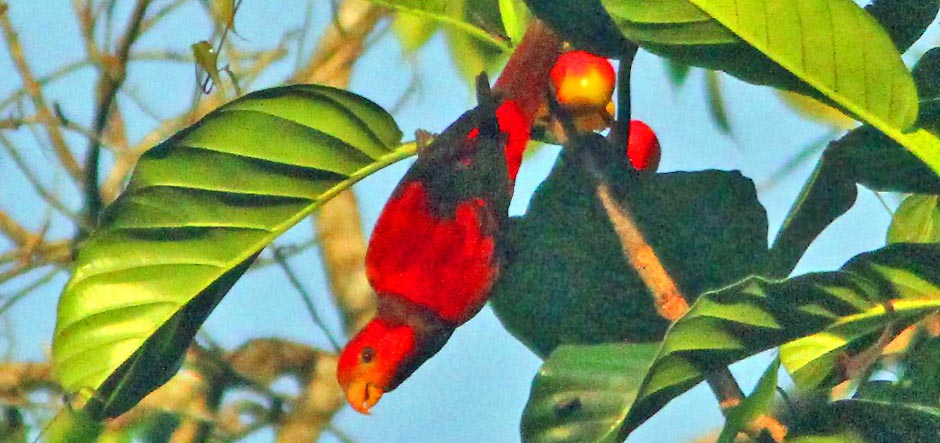






 Parrots are a very large group of easily recognized birds, generally restricted to the tropics around the globe. The most recent evidence could be used to group the Psittaciformes into as few as 3 or 4 families, or split them into as many as a dozen families. Following additional evidence on lineages within the parrots [e.g., Schweizer et al. 2011, Joseph et al. 2013, Rheindt et al. 2014], both Cracraft (2013) and the South American Checklist Committee (2014) have adopted a four-family solution. I now take that step for these family pages (more details in the shaded box at bottom of page).
Parrots are a very large group of easily recognized birds, generally restricted to the tropics around the globe. The most recent evidence could be used to group the Psittaciformes into as few as 3 or 4 families, or split them into as many as a dozen families. Following additional evidence on lineages within the parrots [e.g., Schweizer et al. 2011, Joseph et al. 2013, Rheindt et al. 2014], both Cracraft (2013) and the South American Checklist Committee (2014) have adopted a four-family solution. I now take that step for these family pages (more details in the shaded box at bottom of page).  This "new" family of parrots has four major components:
This "new" family of parrots has four major components: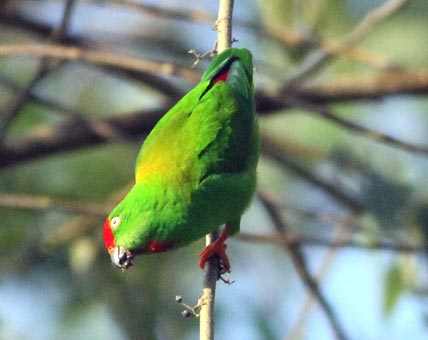
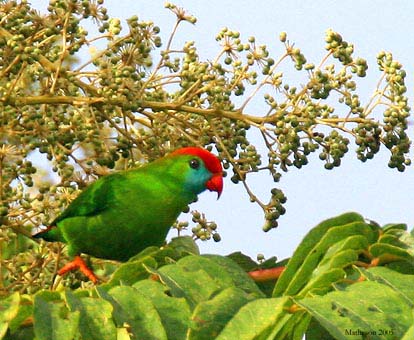
 It is the lorikeets and lories, often placed in a subfamily [Loriinae] and sometimes considered their own family (e.g., Clements 1991), that are known for their brush-tipped, nectar-feeding tongues. This Rainbow Lorikeet (left, in a great shot by Murray Lord) is feeding on flowers with that adaptation. There are 53 species in a dozen genera, all confined to Australasia, eastern Indonesia, or remote South Pacific islands. Some are abundant and widespread, like the Rainbow Lorikeet, but many others are scarce and local.
It is the lorikeets and lories, often placed in a subfamily [Loriinae] and sometimes considered their own family (e.g., Clements 1991), that are known for their brush-tipped, nectar-feeding tongues. This Rainbow Lorikeet (left, in a great shot by Murray Lord) is feeding on flowers with that adaptation. There are 53 species in a dozen genera, all confined to Australasia, eastern Indonesia, or remote South Pacific islands. Some are abundant and widespread, like the Rainbow Lorikeet, but many others are scarce and local.
 Fortunately, many Australasian parrots are common and widespread, such as Crimson Rosella (left) in eastern Australia. At places like O'Reilly's, in Lamington Nat'l Park, Queensland, or Badger Weir park in Victoria, these wild rosellas have become tame and will eat out of your hand (below). At the latter spot, so will Australian King Parrot (on the girl's left hand), a species that shows strong sexual dimorphism. Another colorful example of an Australian parrot is Red-capped Parrot, endemic to the southwest (just below).
Fortunately, many Australasian parrots are common and widespread, such as Crimson Rosella (left) in eastern Australia. At places like O'Reilly's, in Lamington Nat'l Park, Queensland, or Badger Weir park in Victoria, these wild rosellas have become tame and will eat out of your hand (below). At the latter spot, so will Australian King Parrot (on the girl's left hand), a species that shows strong sexual dimorphism. Another colorful example of an Australian parrot is Red-capped Parrot, endemic to the southwest (just below). 
 Man has had a long history of association with parrots. Obviously, keeping parrots as pets is a major hobby. Our fascination with parrots is not limited to their beauty and unique bill, but a number of species are good mimics and can be taught to "talk." Many species remain threatened by this commerce. The Red-and-blue Lory Eos histrio of islands north of Sulawesi is currently being "vacuumed" out of existence by a wild parrot trade. The Mindoro Racquet-tail (right), endemic to that single island in the Philippines, qualifies as Vulnerable on the basis that it may have small population – numbering fewer than 10,000 mature individuals – which is inferred to be in on-going decline owing to the continued loss and degradation of optimal habitat and significant trapping pressure (Birdlife International). It is one of ten species of racquet-tail (genus Prioniturus) ranging from the Philippines to the Moluccas, and most species are declining. Collar (1997) has a fine summary of the impact on psittacines by illegal smuggling, plus the hope for the future with strengthened international laws and protocols.
Man has had a long history of association with parrots. Obviously, keeping parrots as pets is a major hobby. Our fascination with parrots is not limited to their beauty and unique bill, but a number of species are good mimics and can be taught to "talk." Many species remain threatened by this commerce. The Red-and-blue Lory Eos histrio of islands north of Sulawesi is currently being "vacuumed" out of existence by a wild parrot trade. The Mindoro Racquet-tail (right), endemic to that single island in the Philippines, qualifies as Vulnerable on the basis that it may have small population – numbering fewer than 10,000 mature individuals – which is inferred to be in on-going decline owing to the continued loss and degradation of optimal habitat and significant trapping pressure (Birdlife International). It is one of ten species of racquet-tail (genus Prioniturus) ranging from the Philippines to the Moluccas, and most species are declining. Collar (1997) has a fine summary of the impact on psittacines by illegal smuggling, plus the hope for the future with strengthened international laws and protocols.
